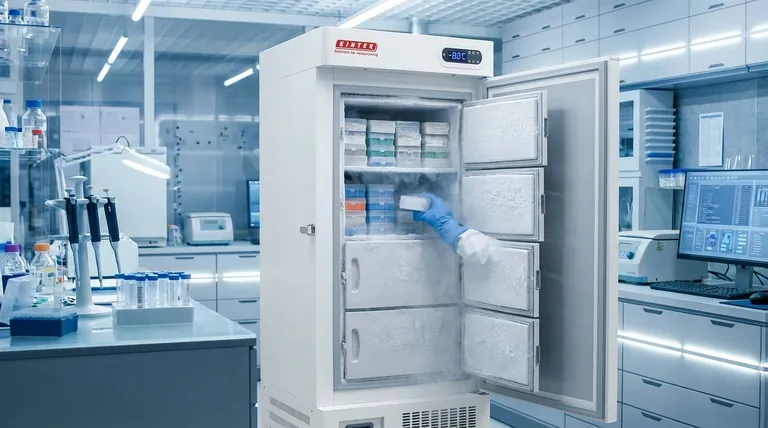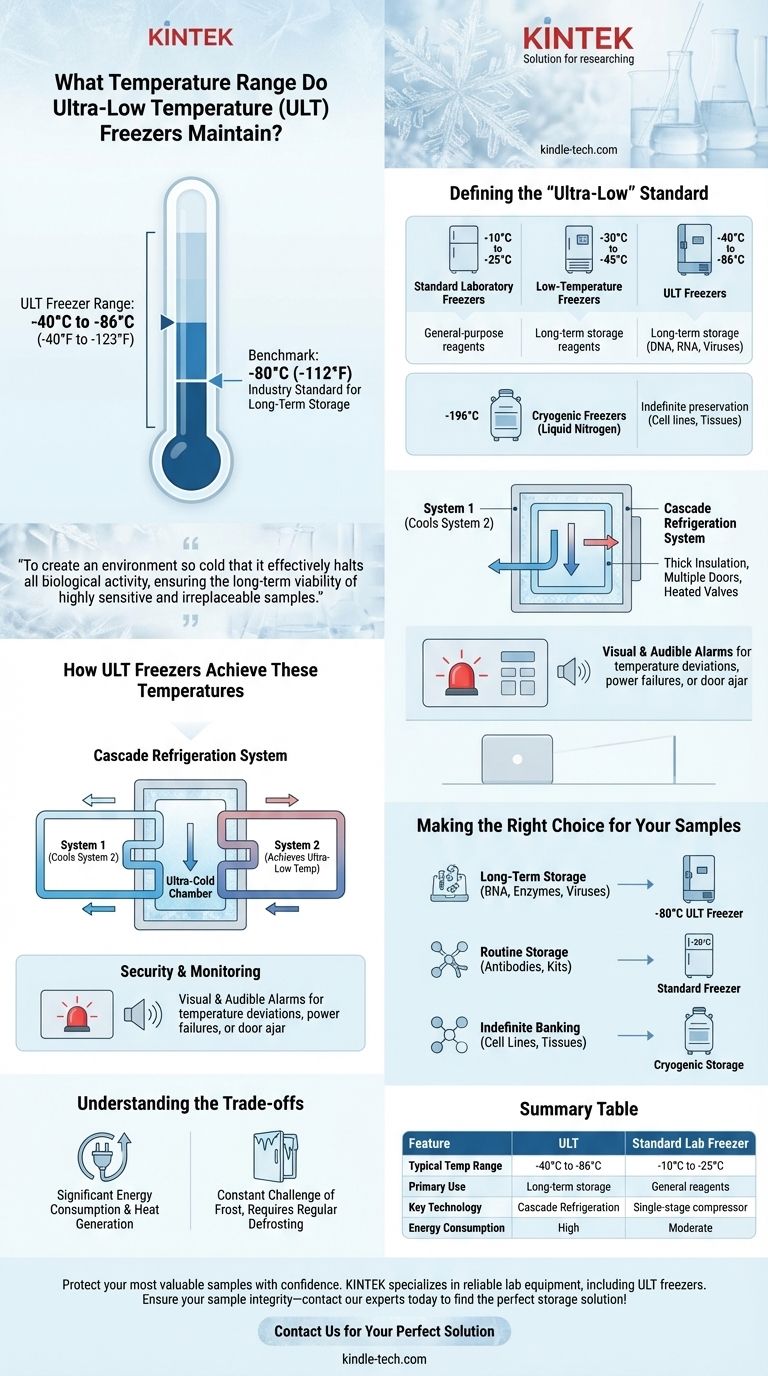In short, a true Ultra-Low Temperature (ULT) freezer maintains a stable temperature range between -40°C and -86°C (-40°F and -123°F). While the exact range can vary by model, the vast majority of these units are designed to operate consistently at or around the benchmark of -80°C.
The specific temperature range of a ULT freezer is less a single number and more a reflection of its core purpose: to create an environment so cold that it effectively halts all biological activity, ensuring the long-term viability of highly sensitive and irreplaceable samples.

Defining the "Ultra-Low" Standard
The term "ultra-low" distinguishes these specialized units from other common types of laboratory cold storage. Understanding these distinctions is critical for selecting the correct equipment and protecting your samples.
The Common Operational Range
While the technical capability of a ULT freezer spans from -40°C to -86°C, most are set to a single target temperature, most commonly -80°C. This temperature has become the industry standard for the long-term storage of materials like DNA, RNA, viruses, and other critical biological samples.
Distinguishing from Other Freezer Types
It's easy to confuse different classes of scientific freezers. The key difference is the minimum temperature they can reliably maintain.
- Standard Laboratory Freezers: Operate between -10°C and -25°C. They are suitable for general-purpose reagents and less sensitive materials.
- Low-Temperature Freezers: Occupy a middle ground, often reaching -30°C to -45°C.
- ULT Freezers: Represent a significant technological step up, consistently holding temperatures in the -40°C to -86°C range.
- Cryogenic Freezers: Use liquid nitrogen to achieve temperatures around -196°C for the indefinite preservation of cell lines and tissues.
How ULT Freezers Achieve These Temperatures
Reaching and maintaining such extreme cold requires specialized engineering that goes far beyond a standard compressor.
The Role of Cascade Refrigeration
The most critical technology is the cascade refrigeration system. This is essentially two refrigeration systems working in tandem. The first system cools the second, allowing the second system to reach a much lower temperature than a single system ever could.
Design for Absolute Stability
Every aspect of a ULT freezer is designed to protect the internal temperature from outside fluctuations.
Key features include robust, thick insulation, multiple internal doors for each shelf to minimize cold air loss when the main door is opened, and heated pressure release valves to prevent a vacuum from forming and sealing the door shut.
Security and Monitoring
Given the value of the samples stored, ULT freezers are equipped with sophisticated visual and audible alarms. These systems alert users to temperature deviations, power failures, or if a door is left ajar, providing crucial time to prevent sample loss.
Understanding the Trade-offs
Operating at such extreme temperatures comes with inherent challenges that users must manage.
Significant Energy Consumption
Cascade refrigeration systems are powerful and consume a substantial amount of electricity. They also generate significant heat, which must be properly ventilated from the laboratory space.
The Constant Challenge of Frost
The large temperature difference between the freezer's interior and the ambient room air leads to rapid frost formation, especially around door seals. Regular defrosting and cleaning are necessary to ensure the door seals correctly and the unit operates efficiently.
Making the Right Choice for Your Samples
Selecting the right cold storage is a critical decision based entirely on the stability requirements of your materials.
- If your primary focus is long-term storage of RNA, enzymes, viruses, or cell extracts: A ULT freezer operating at -80°C is the established industry standard.
- If your primary focus is routine storage of common antibodies or molecular biology kits: A standard -20°C laboratory freezer is often sufficient and far more energy-efficient.
- If your primary focus is indefinite banking of cell lines or tissues: You must use cryogenic storage, as even -80°C is not cold enough to completely halt all degenerative processes over many years.
Ultimately, choosing the correct freezer is the first and most critical step in safeguarding the integrity of your work.
Summary Table:
| Feature | ULT Freezer | Standard Lab Freezer |
|---|---|---|
| Typical Temp Range | -40°C to -86°C (-80°C standard) | -10°C to -25°C |
| Primary Use | Long-term storage of DNA, RNA, viruses | General reagents, less sensitive materials |
| Key Technology | Cascade Refrigeration System | Single-stage compressor |
| Energy Consumption | High | Moderate |
Protect your most valuable samples with confidence. Choosing the right Ultra-Low Temperature freezer is critical for the long-term viability of biological materials like DNA, RNA, and viruses. KINTEK specializes in providing reliable lab equipment, including ULT freezers, to meet the precise demands of your laboratory. Ensure your sample integrity—contact our experts today to find the perfect storage solution for your needs!
Visual Guide

Related Products
- 158L Precision Vertical Ultra Low Freezer for Laboratory Applications
- 508L Advanced Vertical Ultra Low Temperature Freezer for Critical Laboratory Storage
- 938L Vertical Ultra Low Temperature Freezer for Advanced Laboratory Storage
- 808L Precision Laboratory Vertical Ultra Low Temperature Freezer
- 408L Advanced Vertical Laboratory Ultra Low Temperature Freezer for Critical Research Material Preservation
People Also Ask
- Where are ultra low temperature freezers commonly used? Essential for Labs, Hospitals, and Biotech
- In what fields are ultra low temperature freezers most commonly used? Essential for Biomedical, Clinical, and Research Labs
- What advantages do ultra-low temperature freezers offer? Ensure Long-Term Sample Integrity and Reliability
- What are the common applications of ultra-low temperature freezers? Preserve Your Most Valuable Samples
- What are ultra-low temperature freezers designed for? Preserving Your Most Valuable Biological Samples



















